Creation: The Modern View Stepping Backward II

A Sunday guest post by my brilliant husband, Gregg.
Every Sunday, my clever husband offers me a “day of rest” by taking over the homemaker duties here. His primary topic, the Biblical Truth of Creation vs. Darwinism, is a subject that has broad reaching scientific, social, and metaphysical implications and is gaining more and more attention in our modern culture. For believers and non-believers alike, the primary purpose is to present scientific, historical, logical, and/or sociological data in an empirical and defensible fashion, as much as possible written in layman’s terms, and in a format suitable for supplementing any homeschool curriculum whether you choose to believe the Biblical account — or secular guesses — about the origins of human life on earth.
Two Approaches to Darwinism
Continuing this unintended series, I was very sincerely looking forward to digging into Information Theory and really getting under the covers of some of the laws, paradigms, and theorems governing Information and Knowledge. But recent events opened my eyes to the fact that a number of my recent detractors are thoroughly ignorant of the actual claims made by modern Darwinists. Much like immature Christians, these spiritually immature Darwinists are ignorant of the core tenets of their secular and materialist religion. Before I can move forward into Information Theory, I felt called to put sufficient factual material into this public forum so that the discussion could rise above the current level of ignorance.

All things considered, I suppose it would be easier — for my detractors — if I were to passively consent to endlessly repeat myself, isolating my side of the main argument only to very finite details of the Darwinist religion here-and-there, those minuscule items of data with which my opponents have more than a passing familiarity. Then, those tiny little shreds of insignificant points could be held up as straw men amidst the multitude of monolithic refutations I can present, have presented, and will continue to present. Those little nothing straw men could then be ceremonially burned in effigy for the satisfaction of the lemmings, and the spiritually immature Darwinist detractor could then leave the field feeling victorious and even, dare I say, a bit self-righteous.
In spite of how comforting and convenient that would be for my detractors, I am afraid I simply must present a bit more of a challenge. I am going to ask that the Darwinists who visit here each week behave in a little more highly “evolved” and “enlightened” manner. I simply must attempt to confront opponents of a biblical world view with the actual monolithic arguments that refute the grandiose nonsense inherent in Darwinism.
I determined that the easiest way to explain modern Darwinists beliefs for the benefit of my spiritually immature Darwinian detractors was via a two-pronged approach. In last week’s post, I examined the modern Darwinist philosophical beliefs as well as the staunchly defended belief in “micro-evolution” which normal people not afflicted by Darwinism often call “parents having children.” This week, I will cover “Macro-evolution” hopefully in enough detail to satisfy even my most immature detractor.
Next week, I intend to conclude the first part of this series, explaining the Darwinist view from the present working backward, and I intend to work all the way back to the beginning of the universe. After that, I will take a historical view and move forward to the modern day. Hopefully, once I have finished outlining the Darwinian bible, and my Darwinian opponents are all up to speed and have educated themselves about what their literature claims they believe, then I can get back into the Information related material which I, personally, find simply fascinating.
Macro-Evolution! The “Grand Assumption” We Must Accept as FACT!
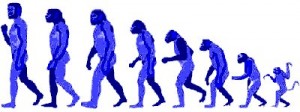
A Darwinists assumes that if we climb his family tree back far enough that somewhere up in his lineage about 50-100,000 years ago you will find a “primitive man,” and about 100,000 years before that some kind of “walking ape,” and several hundred thousand to a few million years before that a full blown ape. This famous “Walk of Life” is an assumption and exists in the imagination of Darwinists — and in middle school and high school textbooks — and doesn’t exist anywhere else. It is not supported by any actual facts, or any operational, observational, or empirical science, but rather is a fictional construct invented solely to support the assumption of the Darwinian Philosophical Bias.
Carrying it back further, Darwinists assumes that a few more million years before that you will find some kind of “mouse-like mammal,” and a few more million years before that some kind of “prehistoric amphibian,” and a few more million years before that some kind of fish, and a few more million years before that some kind of “simple” sea creature, and a few more million years before that some kind of asexually reproducing single celled life form of unknown specificity from which ALL KNOWN LIFE on planet earth “evolved.” It is assumed all live evolved by acts of what is generically and vaguely referred to as “macro-evolution” which term lends a great deal of Scientific Authority and weight to Darwinism as a whole, you see. Because absolutely everything must be seen through the lens of the Philosophical Bias of the Darwinian evolutionary model.
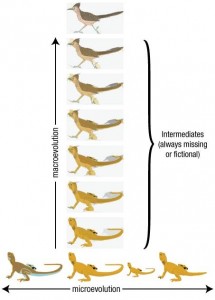 It is important that the tenet “macro-evolution” remain as generic and vague as possible. In this way, in the comforting shade of this giant fuzzy umbrella term, Darwinist do not have to justify the entire religious belief all at once. Instead, they merely have to rationalize a few tiny facets of this incredible assumption as specific objections are raised. Darwinists will often ask skeptics words to the effect, as I have been asked MANY times and repeatedly in the comments of this very blog, “What exactly do you think macro-evolution is? Be as specific and as detailed as possible.” meanwhile, they constantly move the goalpost with respect to exactly what they define macro-evolution to mean.
It is important that the tenet “macro-evolution” remain as generic and vague as possible. In this way, in the comforting shade of this giant fuzzy umbrella term, Darwinist do not have to justify the entire religious belief all at once. Instead, they merely have to rationalize a few tiny facets of this incredible assumption as specific objections are raised. Darwinists will often ask skeptics words to the effect, as I have been asked MANY times and repeatedly in the comments of this very blog, “What exactly do you think macro-evolution is? Be as specific and as detailed as possible.” meanwhile, they constantly move the goalpost with respect to exactly what they define macro-evolution to mean.
Logic question. Why should I have to explain what Darwinists believe when I don’t believe it? That isn’t even logical at a fundamental level. Why not explain what you, as a modern Darwinist, believe based on your assumptions and then defend your position with evidence, logic, and facts? Is it that you are unsure of what you are supposed to believe? Or would you rather vacillate in chains over this or that tiny little straw-man, because you know as well as I do that the entire notion is essentially indefensible in terms of operational, observable, and empirical science?
But today, they get your wish. Here is the summary of my understanding of what Darwinists refer to as “macro-evolution.”
The term “macro” evolution first appeared in 1937 with the publication of Genetics and the Origin of Species by Theodosius Dobzhansky who, along with notables such as Ernst Mayr, was one of the architects of what is called the Modern Evolutionary Synthesis which is the type of evolution currently and predominantly preached in textbooks to innocent children. What they seem to leave out is Dobzhansky’s very precise and rather telling definition.
“There is no way toward an understanding of the mechanism of macroevolutionary changes, which require time on a geological scale, other than through a full comprehension of the microevolutionary processes observable within the human lifetime. For this reason we are compelled at the present level of knowledge reluctantly to put a sign of equality between the mechanisms of micro– and macro-evolution, and proceeding on this assumption, to push our investigations as far ahead as this working hypothesis will permit.” Theodosius Dobzhansky, Genetics and the Origin of Species, 1937, (emphasis added)
Understand that this deeply held assumption of “macro-evolution” as fact is staunchly defended even though 1) there is no possible way that the massive amounts of highly specific and enormously complex genetic information needed to make these kinds of enormous and rapid speciation changes can randomly be infused into the genome by way of any reasonable or recognized “evolutionary” engine on time and in the correct order and 2) operational, observable, and empirical science do not now nor have they ever supported the assumption, and 3) there is a complete absence of any kind of transitional forms in the fossil record for ANY species on planet earth, let alone amoeba to man to support the assumption. Darwin himself acknowledged this.
“Why then is not every geological formation and every stratum full of such intermediate[1] links? Geology assuredly does not reveal any such fine graduated organic chain; and this, perhaps, is the most obvious and serious objection which can be urged against the theory [2 read: assumption].” Charles Darwin, On the Origin of Species By Means of Natural Selection or the Preservation of Favoured Races in the Struggle for Life [1]intermediate: being or occurring at the middle place, stage, or degree or between extremes [2] in this context the word theory is not intended to mean a scientific theory, but rather an assumption made for the sake of argument, in this case an assumption that the fossil record will hopefully be brimming with transitional forms
Darwinists will often argue the fossil record issue citing skeletons of birds and insisting that they are lizards for instance, and sometimes point to micro-evolutionary straw-men such as speciation events to fallaciously address the observable science point, but they never intelligently argue the complexity point, falling back on “randomness” and “chance mutation” as the engine for such structured change.
But table these facts for a moment, please. Turn your logical brain off. Understand that “Macro-evolution” is THE PRIMARY and rather Grand Assumption that is required in order to then accept every other possible form of evolution in the Darwinian evolutionary model. If one can merely accept that “macro-evolution” is a fact — ignoring all of the logic that argues against it, all of the absence of evidence to support it, and all of the evidence that flatly refutes it — and somehow come to the conclusion that “macro-evolution” takes place in our world, then the rest of the Darwinian fairy tale suddenly becomes much more palatable.
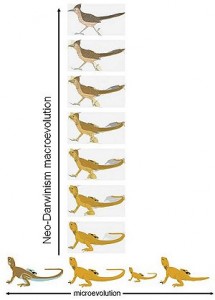
Darwinists believe this primary tenet of their religion, the assumption of “macro-evolution” as fact, based on one of two hypotheses.
Hypothesis number 1
Hypothesis number 1 is called Neo-Darwinism. The term Neo-Darwinism first appeared in 1895 (or 1896, there seems to be some dispute) used by George Romanes who coined the term Neo-Darwinism to refer to the version of evolution advocated by Alfred Russel Wallace and August Friedrich Leopold Weismann. Those gentlemen staunchly refuted the Larmarkism advocated in the first editions of Darwin’s racist book and leaned more strongly toward natural selection as the true evolutionary engine. The bottom line is that Neo-Darwinism emphasizes slow, gradual changes over millions (now billions) of years by means of natural selection.
Neo-Darwinism is the hypothesis firmly embraced by such notables as Richard Dawkins who describes evolution as a long, gradual climb up a very, very long but gentle slope. With typical authoritative sounding aplomb, this is called “Phyletic Gradualism.”
The “Phyletic Gradualism” hypothesis asserts that “macro-evolution” generally occurs uniformly and by the steady and gradual transformation of entire lineages and that is called — now, get this –“Anagenesis.”
In this view, Darwinian evolution is seen as generally smooth and continuous and taking a very, very long periods of time. “Anagenesis” is basically uniformitarianism taken to the extreme.
Hypothesis number 2
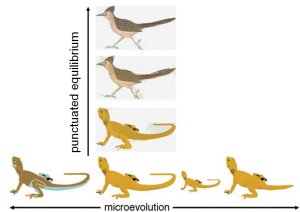
Hypothesis number 2 is called Punctuated Equilibrium. Punctuated equilibrium is the hypothesis which proposes that species experience very little net [macro-]evolutionary change for most of their “geological history,” remaining in an extended state of little or no net change called (with all due Scientific sounding Authority, mind you) “stasis.” Punctuated equilibrium proposes that “stasis” is broken by rare events of very large net change, characterized by rapid events of branching speciation called — okay, now you have to get this — called “Cladogenesis.”
Stop laughing. They are very serious about this stuff.
Now, “Cladogenesis” is the process by which species very suddenly— and as a result of as yet unknown or unidentified “evolutionary forces” –will split into two distinct species, rather than one species gradually transforming into another over long periods of time.
“Punctuated equilibria is a model for discontinuous tempos of change [in] the process of speciation and the deployment of species in geological time.” Stephen Jay Gould & Niles Eldredge, “Punctuated equilibria: the tempo and mode of evolution reconsidered,” 1977
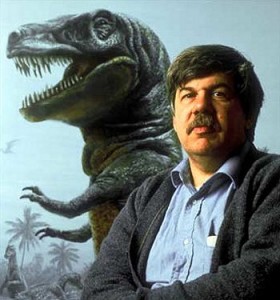
Often, a Darwinist will staunchly defend either one or the other hypothesis, seemingly at random or at will, apparently depending entirely upon which hypothesis looks to be less foolish in the argument at hand. But whichever hypothesis the Darwinist chooses to believe in at the time, it is important to understand that both rely upon obscenely weak assumptions in addition to the Grand Assumption that this type of evolution can even ever occur in the first place.
Getting back to definitions, let me define the word duplicitous. In the last 20 years or so, modern-day Darwinists suddenly started to define “macro-evolution” to include “speciation” but Dobzhansky specified that “macro-evolution” encompassed the assumed unobservable evolutionary Phyletic changes, and he and all of the other architects of the Modern Evolutionary Synthesis had already observed speciation taking place at the time of that writing. But despite that, just in the last quarter century or so, duplicitous Darwinists decided to move the goalpost and make the big fuzzy umbrella definition of “macro-evolution” significantly larger so that it now encompasses elements of “micro-evolution.”
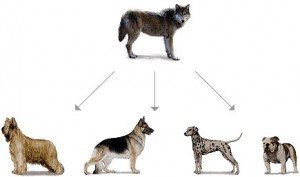
Obviously, speciation occurs. Dogs turn into dogs. Lizards turn into lizards. Birds turn into birds. Equally obvious is that believers in the Biblical account of Creation have always, since the beginning, recognized and affirmed the processes Darwinists traditionally refer to as “micro-evolution” which normal people not afflicted with Darwinism more often call “parents having children,” which processes include natural selection and speciation because these are observable phenomenon. As it happens, this is described in Genesis and encompass the concept of a “created kind” which generally is observable at the Family level.
There was even an abortive effort by Darwinists in the late 1990’s to stop using the terms macro and micro in describing evolution. The claim, at the time, was that the terms were “invented” by “those expletive expletive Creationists” and not a term that had been used to form the Modern Evolutionary Synthesis, never terms that were discussed in the modern classroom. This effort died out, in large part I think because of better channels of communicating factual information.
Again, it goes without saying that Darwinists borrow Dobzhansky’s “Grand Assumption” in defending “macro-evolution” but I’ll be more specific. Neo-Darwinism assumes that there is time, even in the net billions of years Darwinists believe in, to “evolve” every living thing by means of, pardon me I have to say it, “Anagenesis!” The fact is there isn’t enough time even given every possible mathematical concession, to form even a single protein, much less a single entire living organism.
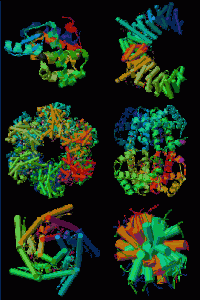
Scientific fact time. First, an amino acid is a highly specific and very complex molecule that can be composed of combinations of Hydrogen, Carbon, Nitrogen, Oxygen, and Sulfur. There are more than a hundred amino acids that are known to naturally occur. Only “L” for laevorotatory or left-handed amino acids make up life on planet earth. In human beings, only 22 L amino acids are used in various metabolic functions including construction of proteins. Only 8 of those are deemed “essential” to life, because we cannot manufacture those 8 and must obtain them via nutrition.
So, half of the possible amino acids, the right handed or “D” for dextrorotatory amino acids are useless to life on earth and in many cases are actually toxic to life. Many other L amino acids outside of the 22 needed to live are also toxic to life, for example the formaldehyde and tars produced by the Urey Miller experiment. One second after death, all amino acids in our body begin to return to a racemic mixture, meaning half D and half L, which racemic mixture is likewise not consistent with life.
Second, proteins are highly specific and very complex chains composed of many hundreds and sometimes thousands of VERY specific amino acids in a VERY specific order with a HIGH DEGREE of complexity in that arrangment. Because a protein is actually a 3 dimensional object that must “fit” together with other proteins absolutely precisely, this highly complex specificity is vital and 100% unforgiving 100% of the time. Thus, any single mistake in the very long sequence of amino acids, one transcription error in the code, results in a completely useless protein.
Now, with that understanding, the smallest known theoretical cell is hypothetically made up of 239 proteins. However, the simplest known non-theoretical self-reproducing organism we actually know of is the H39 strain of PPLO (mycoplasma) containing 625 proteins — a whopping 504% more proteins than the theoretical cell — with an average of 400 amino acids in very specific sequences in each and every protein. The H39 is a tiny thing even in terms of microscopic life. The tiniest, in fact. The average single celled organism has well over 900 proteins and some have well over 2000.
Let’s stick to theoretical cell. At least 124 different very specific types of proteins are needed for this theoretical cell to hypothetically become a living thing. Any single mistake in any single sequence in any single protein results in a non-living mass of organic material, not in a living organism.

Okay — so now that you know all about aminos, proteins, and single celled life forms, here are my points.
The fact is that the probability of the natural occurrence of the smallest possible theoretical life form by means of Darwinian evolution is only 1 chance in 10119,879. That is, one chance out of the number 10 followed by 119,879 zeros.
The years required for the smallest theoretical life form to have evolved would be 10119,841 years — or 10119,831 times the Darwinist assumed 4.2 billion year age of planet earth.
The probability of the smallest theoretical cell — of only a mere 239 proteins evolving without the needed 124 different types of proteins it needs in order to “evolve” this “helpless group of non-living molecules” in less than 500 billion years, not the assumed mere 14.5 billion year old age of the entire universe, is only 1 chance in 10119,701.
In summary, it is beyond ridiculous to assert that there has been enough time for “macro-evolution” to have taken place even to form one living cell, much less every species, on this or any other planet in the entire universe.
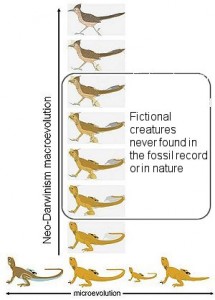
Further, Neo-Darwinism assumes that there is some perfectly reasonable but as yet unknown or unidentified explanation for the complete absence of ANY evidence for this hypothesis in the fossil record. We find tons of lizards changing into — you guessed it — lizards. We never find lizards changing into birds. The mythical transitional forms between lizard and bird only ever exist in well conceived works of art, the imaginations of Darwinists, middle school and high school textbooks, and absolutely never in the fossil record.
Further still, Neo-Darwinism cannot account for the fact that fossils that are found and allegedly dated at millions of years old still somehow have high amounts of Carbon 14 in them when the truth is that after a scant 57,300 years (or 10 half-lives), there would be hardly any left. Why is there C-14 in diamonds? A recently discovered T-Rex femur even still had soft tissue inside. Yet it is supposed to be 65 million years old!? That is some really tough soft tissue!
How accepted is Neo-Darwinism among secular scientists? In a paper predicting the emergence of a new general theory of evolution, one based on the “macromutational” speculations of the Berkeley geneticist Richard Goldschmidt, Stephen J. Gould admitted that neo-Darwinism is “effectively dead.” His hope was that the new theory could fix the time problem and introduce a rescuing device for the other problems like the complete lack of fossil evidence.
Historical Note: When the new theory did not arrive as anticipated, Gould faced the untenable alternatives of either sticking with Dobzhansky, Mayr et. al.’s version of neo-Darwiniam Synthesis, or conceding that biologists still cannot point to a reasonable naturalistic mechanism of any kind which could possibly produce specific biological order and complexity that would account for “macro-evolution.” Gould beat a hasty retreat back to classical Darwinism, thus avoiding giving further aid or comfort to the enemies of Methodological Naturalism and the secular world view.
Regardless, the notions of Neo-Darwinism and “Anagenesis” are touted loud and stridently even today because of a philosophical bias that has nothing to do with empirical science, scientific facts, any kind of scientific observation, or a clear understanding of probabilities and simple math.
 Punctuated Equilibrium, the second hypothesis, assumes that some as yet unknown or unidentified “evolutionary force” (which sounds an awful lot like “magic” to me) can lead to, excuse me but I simply must, can lead to “Cladogenesis!” This notion states that, basically, a lizard can “evolve” into an avian, such as a finch, in the space of a scant 50 to 70 thousand years and leave absolutely no trace of having done so in the fossil record. This entire hypothesis was formed and relies upon a void, a negative, an unprovable notion that has never been and can never be observed in operational or empirical science.
Punctuated Equilibrium, the second hypothesis, assumes that some as yet unknown or unidentified “evolutionary force” (which sounds an awful lot like “magic” to me) can lead to, excuse me but I simply must, can lead to “Cladogenesis!” This notion states that, basically, a lizard can “evolve” into an avian, such as a finch, in the space of a scant 50 to 70 thousand years and leave absolutely no trace of having done so in the fossil record. This entire hypothesis was formed and relies upon a void, a negative, an unprovable notion that has never been and can never be observed in operational or empirical science.
So, the irony is that a complete absence of evidence in the fossil record is actually supposed to be the evidence for this hypothesis. Isn’t that convenient?
Q: “Is this hypothesis really true?”
A: “Well of course it is. Look at the complete absence of evidence! Any fool can’t see a shred of proof! How can you question the complete lack of anything suggesting it has ever been observed!?!?”

Detractors include, surprisingly, Richard Dawkins who said that punctuated equilibrium has been “oversold by some journalists”, and contends that the theory “does not deserve a particularly large measure of publicity. It is a minor gloss [an] interesting but minor wrinkle on the surface of neo-Darwinian theory.”
In the case of Punctuated Equilibrium, Gould and Niles obviously rely upon Dobzhansky’s “Grand Assumption.” Gould then creates a magical “sudden and rapid” and of course “evolutionary” change from a lizard to a bird, and throws in the escape mechanism of “saltations” in the fossil record to account for the absence of any true transitional forms.
Now, on this point of transitional forms, I must simply accuse my detractors of either gross and/or willful ignorance. While arbitrarily arguing that I would refuse to acknowledge a transitional form no matter what due to my Christian beliefs, often my detractors simply ignore the fact that believers in the Biblical account of Creation affirm observable speciation, but also take note that the plasticity of any kind of plant or animal has observable limits.
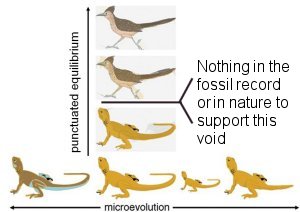
These very real genetic limits within plant and animal kinds are verifiable via observable, operational, and empirical science. They were first hypothesized by Joseph Kölreuter, then by Carl Freidrich von Gärtner, and finally documented by the father of modern genetics, Gregor “Johann” Mendel.
Mendel documented these observable limits in the form of what he noted as “constants.” In his short treatise, Experiments in Plant Hybridization, Mendel describes “constant” characters, “constant” offspring, “constant” combinations, “constant” forms … in total applying the adjective “constant” nearly seventy times in his original paper. Mendel concluded that the laws of heredity he discovered strongly corroborated Carl Freidrich von Gärtner’s conclusion
“Gärtner, by the results of these transformation experiments, was led to oppose the opinion of those naturalists who dispute the stability of plant species and believe in a continuous evolution of vegetation. He perceives in the complete transformation of one species into another an indubitable proof that species are fixed with limits beyond which they cannot change.” Gregor Mendel, 1865
In other words, a dog is still a dog, and always recognizably so, whether it is a Wolf, a Dingo, an English Bulldog, a Great Dane, or a Dachtsund. A lizard is always a lizard, a bird is always a bird, a tulip is a tulip, and a pea is a pea.

Not surprisingly, I am not a believer in either one of these “macro-evolution” hypotheses because I do not believe the grand assumption upon which all macro-evolution is based to be a fact. It has never been shown to be factual. I believe that all living things had original ancestors that were very similar in their genetic make-up to the living species we find on earth today. For example, I believe all dogs came from some kind of original dog pair.
Furthermore, I believe that Adam and Eve had lots of children and that among their descendants were guys named Noah, Ham, Jepeth, and Shem and their wives, and all of them went on a long boat ride. Those guys can be found in my family tree a scant few thousand years ago. I don’t believe there are any “primitive” men or apes in my bloodline anywhere at all. And I don’t think a complete lack of evidence can prove or disprove anything other than that there exists no evidence for either hypothesis.
The Truth
 Darwinists might sneer while worshipping their hypothetical ylem and say, “Oh, yeah? Well, who made your god [sic], then? Who gave him [sic] instructions on how to make the universe?”
Darwinists might sneer while worshipping their hypothetical ylem and say, “Oh, yeah? Well, who made your god [sic], then? Who gave him [sic] instructions on how to make the universe?”
And the answer is, okay, an even more mighty God — a “goddier God” if you will — created that Creator of the universe.
So, the ping-pong argument would continue, who made that “goddier God” then and who told him how to make the creator?
And the answer is, an even more “goddier God” with even more godlike power made that one. And you know what we can do? We can chase that logical rabbit all the way down into the hole, and we can keep inventing more and more powerful beings to create the beings who you don’t see as all powerful and all mighty, and we can follow that chain of causality all the way back. Because an infinite regress of causality is impossible, we can follow it to its conclusion, to what Saint Thomas Aquinas called a “first cause,” what Aristotle referred to as a “prime mover,” and to what must be universally recognized as a Being of absolutely infinite knowledge and absolutely infinite power; a Being who knows absolutely the entire future and the entire past and every grain of sand and every atom in every star, and who exists eternally in eternity — and that Holy, Holy, Holy Being, in answer to the original question, is that whom we can absolutely call God.
And that Creator is the one who created everything by the power of His will. And that Designer is the one who killed me and resurrected me without any of the sins of my past, an absolutely new creation. And that almighty God, by the power of His word, took on human form and became a living sacrifice in atonement for my once very wicked ways. And that amazing Healer rose from the grave and sent a helper to live in the temple of my body. And that Redeemer can do the very same thing for you if you don’t know Him. He can do it RIGHT NOW because absolutely NOTHING is beyond His power.
I commit to you that I will publish every single comment that meets this blog’s commenting criteria. You may want to review that criteria before adding your opinion here.
God Bless you and yours.
Gregg
Resources:
Additional Posts dealing with Creation and Darwinism


I will end my post with these final thoughts. You may reply if you wish….
1) Capitalizing evolution was a typo. If you notice it is not capitalized every time so no intent or underlying message was trying to be conveyed
2) If you “studiously do not to engage in any kind of religious debate” then why create a blog that others may reply and that you may then tell where they are wrong. As you yourself said “be honest”
3) You are correct that some of myremarks are “judgemental” and I apologize and retract them. If your belief is in Christ and you follow your belief in the bible then good for you. However I do the same and should be allowed to follow my own slightly different interpretation of the Word. Your desire to say you are right in what you believe has no more credibility then my own desire to say my belief is right. If we were expected to view every phrase of the bible the same then we would not have been given the power to think.
4) Following up on #3 . As you questioned above “is there actually something wrong with my beliefs outside of my faith in Christ?” The answer is NO! My issues from the start of these posts is the “feeling” that you are pushing your own beliefs and agenda and condemning (or insinuating) that my beliefs are wrong. I admit that I am wrong to say that you are wrong in your beliefs so long as you believe in Christ and his teaching. Therefore I return the questions to you…. is there actually something wrong with my beliefs outside of my faith in Christ?
5) You are obviously intelligent so look closely at how often you speak of the things wrong with my belief, questions, or possible salvation, and in the next moment do the same things that you are telling me I am doing wrong. Believe me, I understand… I see myself having done the same things in my posts. But I’m also willing to admit it and end this discussion. I believe in Christ, you believe in Christ hopefully he will love us both enough to get us into his Kingdom. The peripheral interpretations don’t really matter. And that is as Honest as I can be.
You say, “My issues from the start of these posts is the “feeling” that you are pushing your own beliefs and agenda and condemning (or insinuating) that my beliefs are wrong.”
.
Actually, that’s what you have done with every comment. I did not seek you out. You came to my house. You came to my “living room” plopped down on the couch and immediately “insinuated” that I am an uninformed ignoramus pushing an “agenda” who does nothing but “condemn” others. You didn’t back up your opinion with anything I actually said in any of my posts. I doubt you read more than one of them. Frankly, I find you judgmental, uncharitable, and — worse — impolite.
.
In my opinion, the only difference in our beliefs is I don’t fallaciously cherry-pick what I do and do NOT want to believe from God’s holy word. I believe it ALL and put the word of NO MAN above the holy, infallible, inerrant word of the Living God. If that difference bothers you so much that you have to write all these snarky and judgmental comments to a brother in Christ, perhaps you need to get down on your knees or all the way down on your face before your Creator and ask Him why you want to act like such a Pharisee in public.
.
None of my business. Thanks for your comments either way.
.
God Bless,
Gregg
….”Actually, that’s what you have done with every comment. I did not seek you out. You came to my house. You came to my “living room” …”
.
.
As the writer of the blog this may feel like a very personal space to you. But by the nature of blogging, to a visitor to your blog, it does not feel that way. It feels more like a booth at a community event like a farmers market, or maybe a garage sale or open home tour, where you have specifically invited the public passers-by to take a look at your ideas.
.
At scientific conferences there are poster sessions where participants are given spaces where they can post descriptions of their research. People pass by and read the information. During at least part of the allotted time, one of the authors of the poster stands by it to answer questions or respond to comments and discussion. Some politeness is expected, but for someone to argue against some of the conclusions posted would not be unreasonable. When you post your creation essay it seems to me as if you doing something equivalent: giving your views with the expectation that people will read them and possibly respond, not necessarily in agreement.
This is different from someone walking uninvited into your living room and starting to criticize the decor.
…..Honestly — don’t you think you can get all kinds of different cats without mutation? Don’t you think you can derive all kinds of dogs without mutation? ”
.
.
just to be sure, are you talking about different kinds of house cats and different breeds of domestic dogs?
Or are you talking about lions, tigers, ocelots, cheetahs, house cats, etc? Dogs, wolves, coyotes and jackals? Dogs, wolves, coyotes, jackals and foxes?
…”Honestly — don’t you think you can get all kinds of different cats without mutation? Don’t you think you can derive all kinds of dogs without mutation? Or corn? Or pine trees? Or peas? Or geraniums? Or anything that can sexually reproduce and thus hybridize absent mutation?…”
.
.
Honestly… I think some variations between, for instance, dog breeds could have come from alleles in the original wolf population but I think some other characteristics probably came from mutations. I don’t see it as a big issue one way or another.
.
If you’re talking about, for example, cat ‘kinds’, I read that some types of felines have different numbers of chromosomes, yet they still have produced hybrids. (Now I have to go back and see which ones, but ocelots had a different number from mountain lions. I forget which species the ocelots were able to hybridize with.) If all feline species (lions, tigers, ocelots, house cats etc.) came from an original ‘cat kind’ pair, then there was clearly a mutation at some point to cause a difference in chromosome numbers. Alternatively you could say that there were two different types of ‘cat kind’ on the ark with the two differing sets of chromosomes. But then you have to deal with the fact that they could produce offspring. (I can’t remember if those offspring were fertile; I went on vacation in the midst of thinking about this question).
But I am not clear on whether this is an example that relates to your question. It’s not clear to me that that chromosomal mutation changed the physical characteristics of the cat species, their phenotypes.
.
I gave you an example of spontaneous mutations observed in mouse strains that changed their coats. So it is possible for a mutation to happen which results in an observable coat difference, and coat differences are part of dog and cat breeds. Since most of the breeds were established in the 1800s before genetics information, it might be impossible to show that a particular genetic condition happened in a mutation in a particular dog line.
.
There is a rare Norwegian breed of dog called the Lundehund which has extra toes. Maybe you could imagine a situation where the genetic information for the extra toes was passed down through generations and generations of dog kind ancestors and disappeared except in that one breed in Norway. But it seems more likely to me that it was the result of a spontaneous mutation. There are also some cats that have extra toes, for instance some of the Maine Coon cats. The single base pair genetic variation in some cats with extra toes in the USA is close to in genetic location but different from the mutation which caused some cases of extra-toed cats in the UK. In this case, I don’t think extra toes is a definite breed characteristic of Maine Coon cats but I think it is a common trait in that breed.
I’ll try to think of other approaches to this question.
…Don’t you think you can derive all kinds of dogs without mutation? Or corn?”
.
.
Corn is where Barbara McClintock discovered ‘jumping genes’: transposable elements. This is a kind of mutation.
Here’s an article about locating a mutation responsible for the short-legged phenotype in breeds like dachshunds and pekinese. Their conclusion was that it was a single mutation event that happened before the various current breeds were developed. (The genotype sequence related to the mutation was not found in the dogs they looked at but was found in some wolves. Maybe that means it could have occurred in wolves before dogs became domesticated. It seems unlikely to me that a wolf offspring with that mutation would have survived, and I’d guess it happened after domestication.)
.
http://www.ncbi.nlm.nih.gov/pmc/articles/PMC2748762/?tool=pubmed
Abstract: Retrotransposition of processed mRNAs is a frequent source of novel sequence acquired during the evolution of genomes. The vast majority of retroposed gene copies are inactive pseudogenes that rapidly acquire mutations that disrupt the reading frame, while precious few are conserved to become new genes. Utilizing a multi-breed association analysis in the domestic dog, we demonstrate that a recently acquired fgf4 retrogene causes chondrodysplasia, a short-legged phenotype that defines several common dog breeds including the dachshund, corgi and basset hound. The discovery that a single evolutionary event underlies a breed-defining phenotype for 19 diverse dog breeds demonstrates the importance of unique mutational events in constraining and directing phenotypic diversity in the domestic dog.”
“It feels more like a booth at a community event like a farmers market, or maybe a garage sale or open home tour, where you have specifically invited the public passers-by to take a look at your ideas.”
.
Imagine walking up to the folks at the farmers market booth and calling them ignorant and then casting all kinds of judgements on their lifestyle or “agenda.”
.
Or a garage sale.
.
Or anywhere at all.
.
Sorry. I don’t buy it. It’s just rude.
Cats are felines and dogs are canids.
A mutation that mutates corn into corn.
Cats mutating into cats, mice mutating into mice — no objections. That’s observable science. Cats mutating into mice or vice versa would be more consistent with the evolutionary hypothesis.
.
As Mendel demonstrated nearly a century ago, there are genetic boundaries that all life forms cannot exceed, surpass, or overcome. This is as true for sweat peas as for sapiens. Corn mutating into corn is not evolution in the Darwinian sense. Corn mutating into tomatoes would be.
Dogs mutating into dogs.
…Honestly — don’t you think you can get all kinds of different cats without mutation? Don’t you think you can derive all kinds of dogs without mutation? Or corn?”
.
.
Whoa, wait a minute. I thought you WERE talking about dogs mutating into different kinds of dogs etc, from the quote above. So those the examples I looked for.
.
….Cats are felines and dogs are canids.”
.
So does that mean that in your original sentence quoted above, you didn’t mean dog breeds particularly, but you also meant wolves, jackals, coyotes?
And for cats, not just house cat breeds but lions, ocelots, mountain lions, bobcats, house cats etc?
ALL THAT READING, WASTED!
.
.
(That’s a joke, not really wasted; it was interesting and fun.)
No one can ever seem to give a clear answer for what a species is. A kind is a type of animal that can successfully reproduce or “bring forth each to its own kind” as it says in Genesis. I have no issue with certain individuals within a kind displaying a mutation. No argument. My argument is that such mutations can add information (since mutations are always reductive or static) sufficient to transform say fish into amphibians, or amphibians into lizards, or lizards into mammals. Fish are always fish. Amphibians are always amphibians. Reptiles are always reptiles. Mammals are always mammals. No matter how much “mutation” you throw at a given “kind” it remains an example of that kind.
.
You will never irradiate fruit flies until they become lizards or mammals or plants. They will never even be anything but seriously screwed up fruit flies. They won’t even be able to become some other kind of insect.
But a white dog and a black dog are going to make little white dogs, little black dogs, and little black and white dogs all without mutation. Dogs make dogs. Adding mutation doesn’t change that fact. Dogs will always make dogs whether they have a high or low mutational genetic load.
…”But a white dog and a black dog are going to make little white dogs, little black dogs, and little black and white dogs all without mutation. Dogs make dogs. Adding mutation doesn’t change that fact. ”
.
.
Well, whether you get little white and black spotted dogs depends on genes for color spotting. And whether you get white puppies and black puppies probably depends on the particular genes involved, whether the parents are homozygous or heterozygous for each gene, and if a parent is heterozygous, which chromosome the pup gets.
.
Of course if the dogs were not purebred you might get some other color if for instance each parent were heterozygous for some recessive gene and some puppy inherited two recessive genes.
But also if there happened to be a mutation in the germ cell of one parent for some color gene, you might get pups of some other color.
So you might not get only black and white pups.
But I understand what you mean. And one way or another, you still get dogs… in one generation anyway. (Give it millions of years and many generations, and I think you might get something different.)
.
.
.….”Cats are felines and dogs are canids.”
.
Oh, I get it now. I think you meant that when you said cats you meant all feline species etc. Okay.
.
.
.
…”As Mendel demonstrated nearly a century ago, there are genetic boundaries that all life forms cannot exceed, surpass, or overcome.”
.
No, Mendel did not demonstrate that, nor was he able to demonstrate that.
“(Give it millions of years and many generations, and I think [e.g.: believe] you might get something different.)”
.
This is a philosophical statement based on a religious belief.
.
It cannot be observed and therefore has nothing in common with operational science.
.
It has never been observed and therefore has nothing in common with operational science.
.
It cannot be tested and therefore is utterly and forever separate from the scientific process itself.
.
With all of the authority of operational science, I can say that it has never been observed, can never be observed, cannot be tested, and therefore is not a scientific statement.
.
When you remove science from philosophical beliefs, you enter into the realms of magic. Example: Give it millions of years and many generations, and magically dogs will transform into cats or bats or lizards despite all scientific evidence to the contrary.